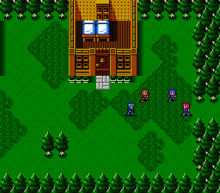Fire Emblem Gaiden
| Fire Emblem Gaiden | |
|---|---|
 Foreground characters (left to right): Celica, Alm and Valbar | |
| Developer(s) | Intelligent Systems |
| Publisher(s) | Nintendo |
| Director(s) | Shouzou Kaga |
| Producer(s) | Gunpei Yokoi |
| Artist(s) | Naotaka Ohnishi Satoshi Machida Toshitaka Muramatsu |
| Writer(s) | Shouzou Kaga |
| Composer(s) | Yuka Tsujiyoko |
| Series | Fire Emblem |
| Platform(s) | Family Computer |
| Release date(s) |
|
| Genre(s) | Tactical role-playing game |
| Mode(s) | Campaign |
| Distribution | 3-megabit Cartridge |
Fire Emblem Gaiden (ファイアーエムブレム外伝 Faiā Emuburemu Gaiden, literally "Fire Emblem Side-Story"[1]) is the second installment in the Fire Emblem Tactical role-playing game series developed by Intelligent Systems and published by Nintendo. The game was released in Japan on March 14, 1992.
It is also the second Fire Emblem game to be released exclusively on the Family Computer (Nintendo Entertainment System). It serves as a side story to the original game. Set in the same game world, the events of Fire Emblem Gaiden actually take place on a different continent, and thus have no bearing on the first game's story. However, several characters from the original game, such as the pegasus knight sisters, make an appearance.
Gameplay

While the basic battle engine and formula from the original game are still present in Fire Emblem Gaiden, a number of new gameplay features were added or changed. Certain classes feature branching promotion trees, allowing the player to select a character's promotion class. Only special weapons need be equipped, and neither these nor the unit's default weapons will ever break. Spells are learned through leveling up, and they drain the spellcaster's hit points with each use. The game also features an overworld map that players can travel through between battles and towns that can be freely explored, with more territory becoming available as the game progresses.
Despite the numerous changes to the Fire Emblem formula, most of the later games in the series reverted to the gameplay of the original Fire Emblem before evolving into new directions. Some of these changes, such as a navigable world map and branching class promotions were later used in Fire Emblem: The Sacred Stones, which received critical praise for its design. These elements were used again in Fire Emblem: Awakening. However, other elements that Fire Emblem Gaiden introduced have not been reused.
Plot
The game follows two protagonists, lifelong friends Alm and Celica, over the course of five chapters and takes place in two kingdoms on the continent of Valentia: Rigel and Zofia. The world map is slowly revealed for players to traverse through the game's five chapters. Over the course of the game, it is revealed to both Alm and the player that he is actually the prince of Rigel, whereas Celica is both the princess of Zofia and a priestess of the goddess Mila. Fire Emblem Gaiden was the first game in the series where more than one main character could promote. Alm begins the game as a Fighter before eventually promoting to Hero. Celica is a Priestess, and she promotes into Princess.
Reception
Legacy
Fire Emblem Gaiden was adapted into a manga in Monthly GFantasy by Futaba Aoi, who also worked on the Fire Emblem: Ankoku Ryū to Hikari no Tsurugi manga. A remix of the game's songs, "With Mila's Divine Protection" and "Credits" appears on the soundtrack for Super Smash Bros. Brawl. It is a remix of the player's phase theme in Chapter 2 (Celica's first map) and a remixed version of the Fire Emblem theme heard at the end of Fire Emblem Gaiden. The player's attack phase theme is newly arranged in Fire Emblem: The Sacred Stones as the arena battle theme. In Fire Emblem: Fūin no Tsurugi, Alm's Map theme plays during the player's turn phase while in the Trial Maps.
References
- ↑ "Games That Never Made It to America". Nintendo Power (Volume 56): p. 62. January 1994.
External links
- (Japanese) Official website at Nintendo of Japan
- (Japanese) VC Fire Emblem Gaiden website at Nintendo of Japan
- (Japanese) Fire Emblem Gaiden at Fire Emblem Museum
- Fire Emblem Gaiden at MobyGames
- Fire Emblem Gaiden at NinDB
- Fire Emblem Gaiden at Fire Emblem Wiki
- Fire Emblem at Fire Emblem Wikia
| |||||||||||